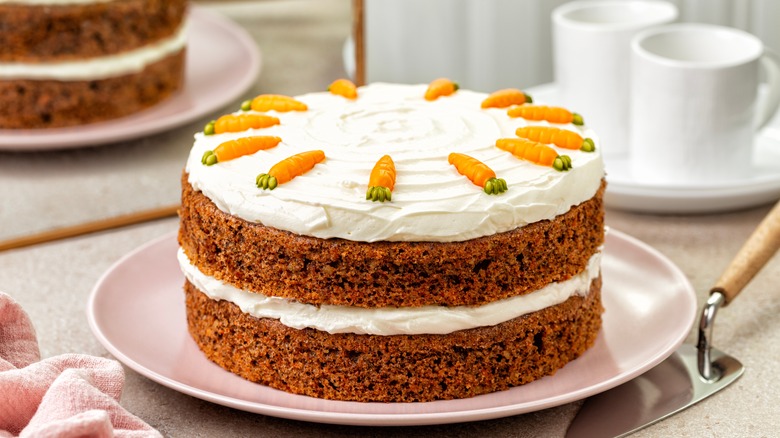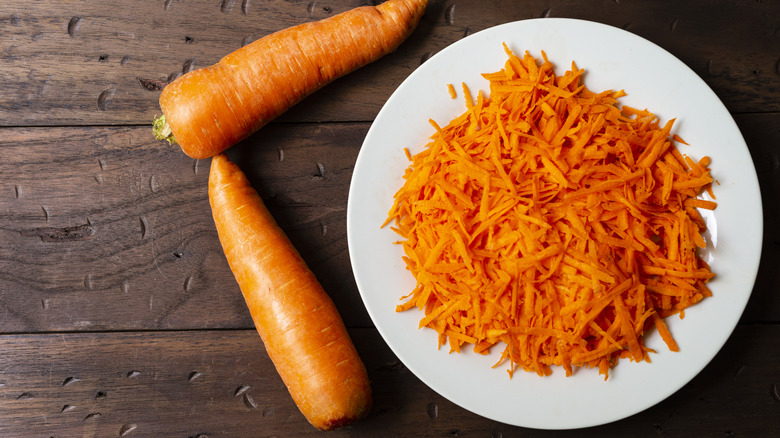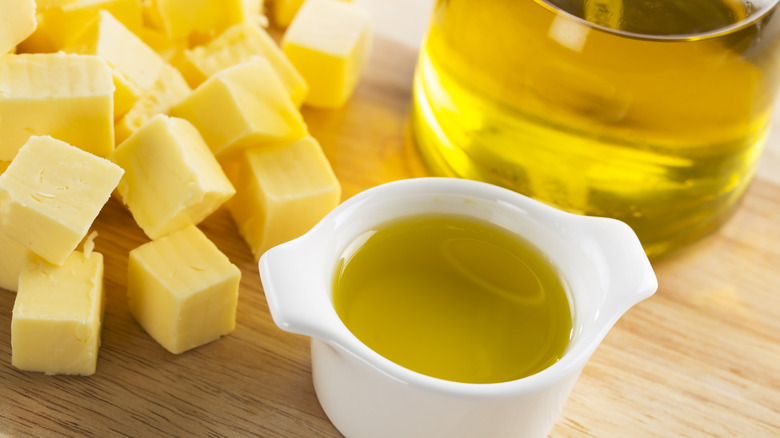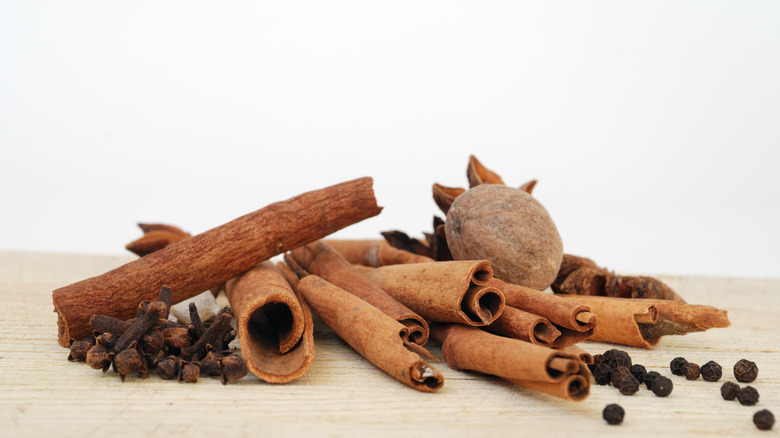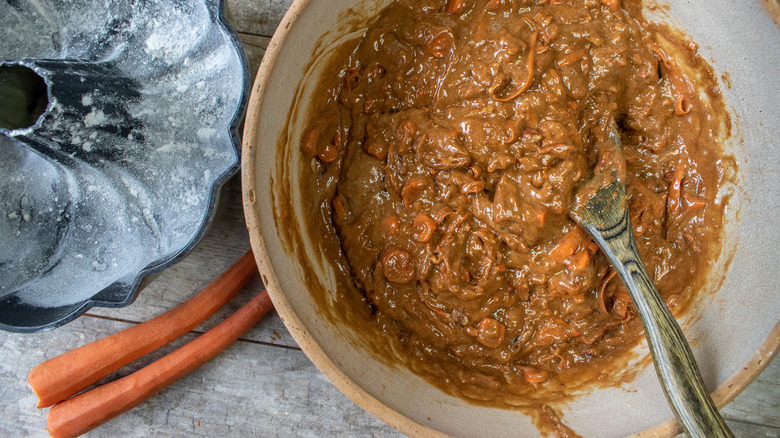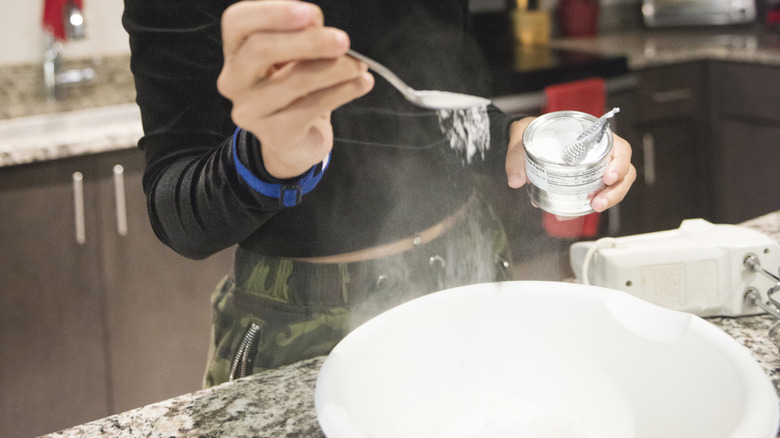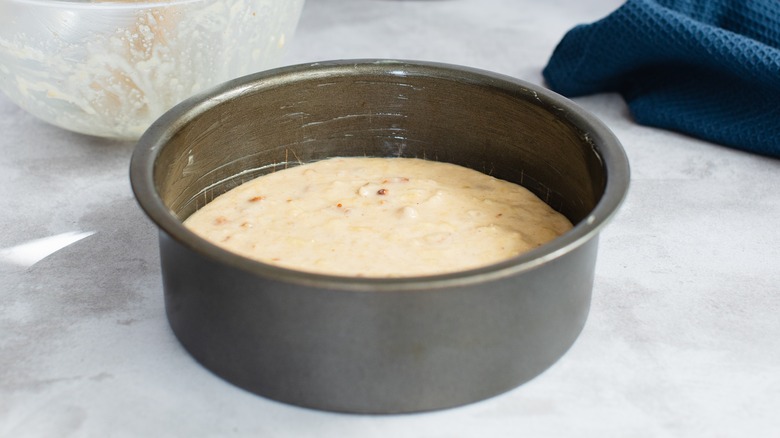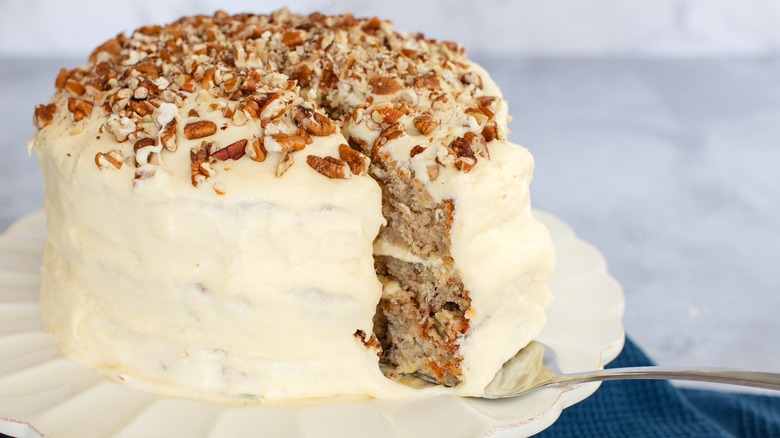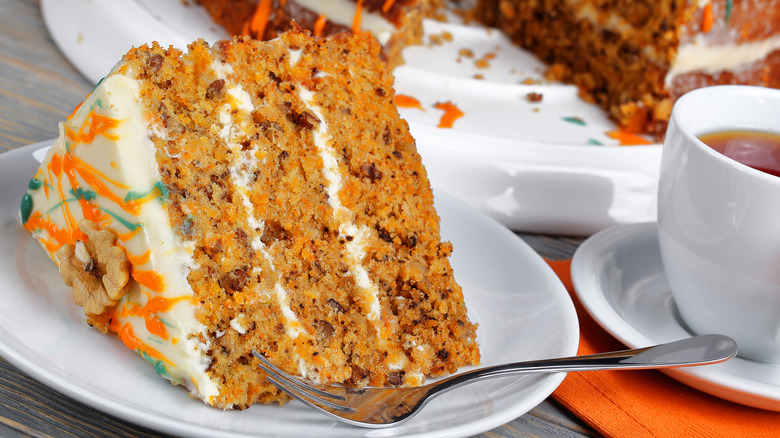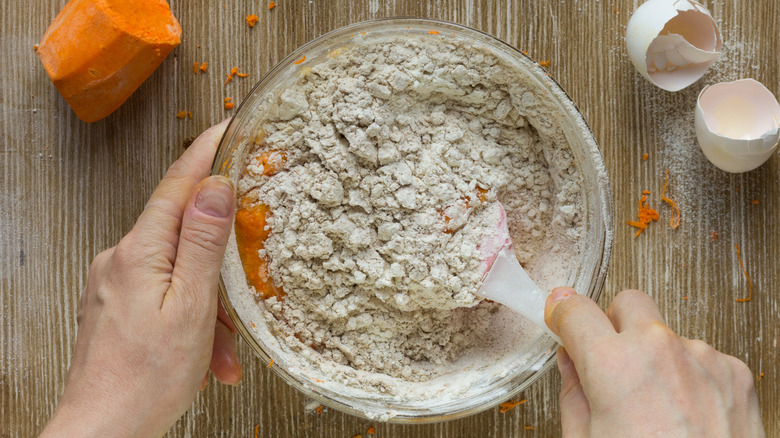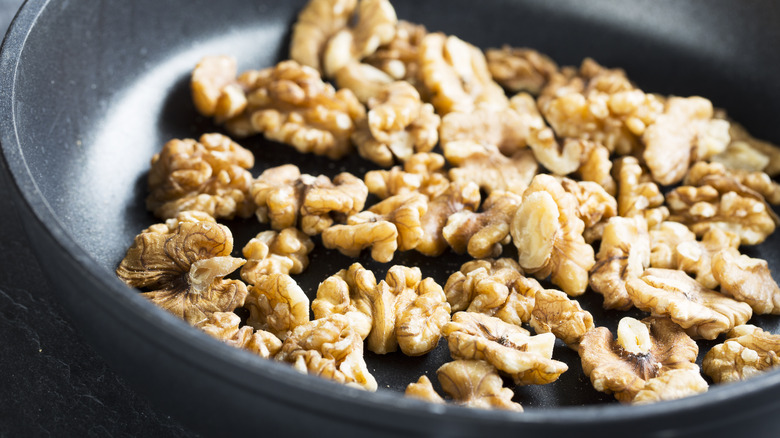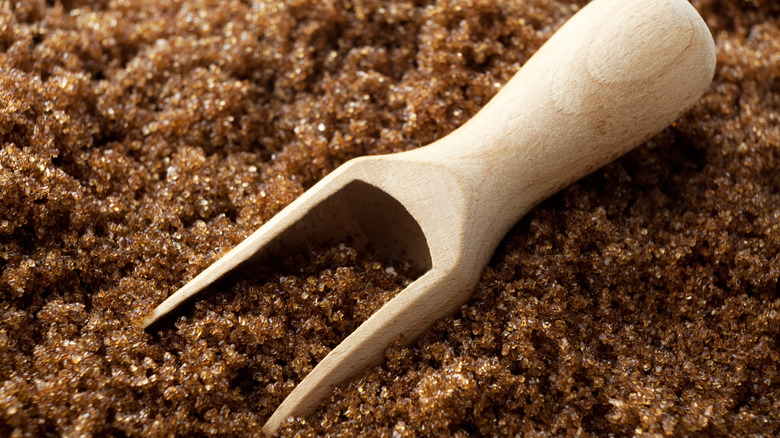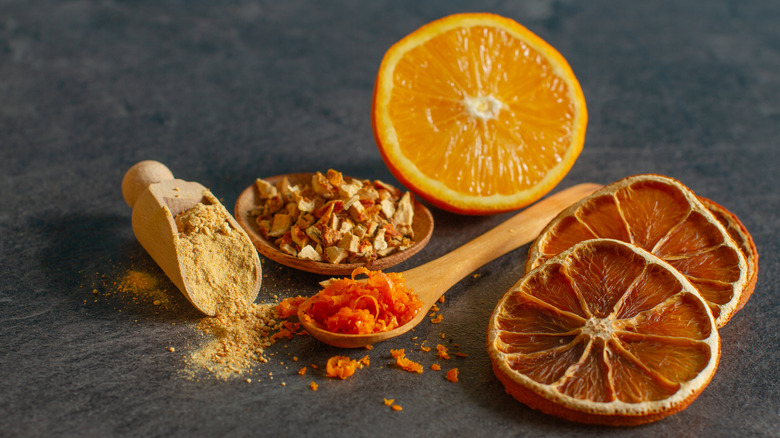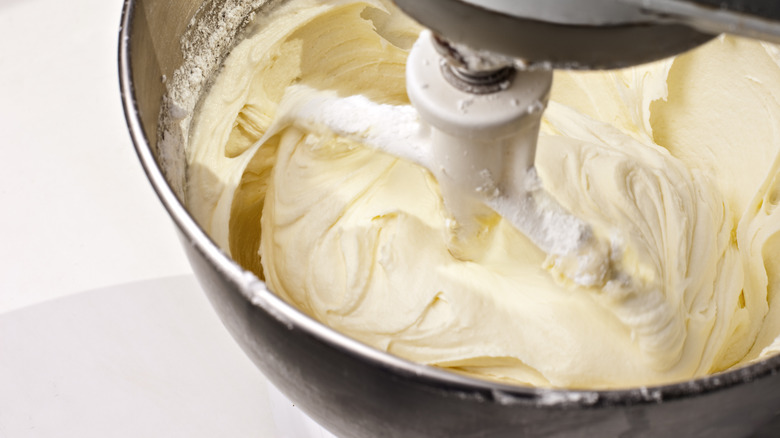13 Mistakes Everyone Makes When Baking Carrot Cake
Carrot cake should be moist, rich, and heavily spiced. So it's a disappointment when it comes out of the oven dry, bland, or sunk in the middle. There are certain mistakes that many people make with carrot cake that can lead to issues. You're not alone, but there are easy fixes, so let's chat about the common slip-ups we've all made in the pursuit of the perfect carrot cake.
Imagine this: Your kitchen is humming with the promise of cinnamon-infused joy, anticipation building as you wait for your cake to bake. But when it comes out of the oven, it's gummy, improperly risen, or crumbling apart.
From the very foundation — those shredded carrots — to the frosting that finishes it off, we're shining a spotlight on the misadventures that can stop you in your stride. We all make mistakes, but it's about embracing them as stepping stones to baking mastery — and learning how to avoid them in the future. We're here to guide you through the nuances of carrot cake alchemy.
Get ready to elevate your carrot cake skills, avoid those common pitfalls, and emerge from the kitchen with a carrot cake so divine it'll have friends and family begging for your secret recipe. Here are some mistakes everyone makes when baking carrot cake and tips on how to avoid them.
1. Grating carrots too large
If you've been grating your carrots on the large side of your box grater, you won't get the best results in your carrot cake. Size matters here, so grab that trusty box grater and opt for the smaller shredding side. Why, you ask? Well, grating your carrots too large is a surefire way to introduce noticeable pieces of stubborn, crunchy carrot in your otherwise heavenly cake.
What you really want is for those carrots to gracefully melt into the cooked cake, becoming one with the batter, imparting moisture and flavor in every crumb. And for that magical integration, you need those shreds to be on the smaller side. Sure, a food processor might save time, but even its smallest shredding blade tends to yield larger carrot pieces compared to the finesse of a box grater. The goal here is subtlety, ensuring that the carrots blend seamlessly into the cake, leaving no trace of their once-solid state.
Now, about those convenient bags of pre-shredded carrots lining the grocery store shelves — resist the temptation. They may save you a few minutes, but the compromise isn't worth it. Pre-shredded carrots tend to be dry and coarsely grated, not giving you the moisture you're aiming for in your carrot cake. So, for the love of all things moist and flavorful, wield that box grater, embrace the small shred, and watch as your carrot cake turns out perfectly.
2. Using butter instead of oil
Carrot cake should contain oil, not butter, and if you've been using butter, you're making a misstep. Now, we know the siren call of butter is strong, but when it comes to achieving that perfect, moist crumb in your carrot cake, it's time to give oil a moment in the spotlight.
Picture a carrot cake so tender that it practically melts in your mouth. The secret ingredient to this textural triumph? Good ol' vegetable oil. Oil has a higher fat content than butter, which helps to get the texture you want from a carrot cake.
Carrot cake recipes generally call for a neutral-flavored oil, allowing the flavors of cinnamon, other spices, and, of course, the carrots themselves to come through. Butter, on the other hand, can introduce a distinct richness that might overshadow the delicate dance of flavors you've carefully orchestrated. That said, if you're craving the taste of butter, you can try part oil and part butter in a carrot cake recipe.
Another perk of oil? It's easy to mix. Carrot cake batter tends to be dense, thanks to the carrots and any add-ins like nuts or raisins. Oil glides into the mix with ease, ensuring a smoother, more homogenous batter compared to the sometimes finicky creaming process with butter.
3. Not using enough spices
Skimping on spices in carrot cake is nothing short of a culinary crime. You're about to indulge in a slice of carrot cake, anticipation building, and then — oh no, it's bland! How did we end up here? Well, it's likely a spice miscalculation. Carrot cakes tend to contain at least a couple of teaspoons of spices, but if you want a bolder flavor, you can absolutely add more.
Cinnamon often takes the lead in carrot cake recipes, and rightfully so. But relying solely on cinnamon can leave your carrot cake lackluster. Embrace other spices for a punchier and more complex flavor. Beyond cinnamon, consider inviting nutmeg, ginger, cloves, allspice, and cardamom to the party. Some people even use fresh ginger or freshly grated nutmeg in their cakes for a boost of flavor. There's no single perfect blend or balance of spices for carrot cake, so it's all about experimentation. You might have to bake a few carrot cakes with different spice blends to find your favorite, but any blend of these spices is sure to be delicious in its own way.
4. Adding too many mix-ins
Adding a lot of mix-ins to your carrot cake might not seem like a potential problem, but it can lead to issues with your bake. We get it — the allure of tossing in a medley of flavorful additions is hard to resist. The promise of a cake bursting with nuts, raisins, and a hint of coconut seems like a flavor jackpot. However, too many mix-ins can lead your carrot cake down a dense and heavy path, and that's a baking detour you might want to avoid.
While the idea of a loaded carrot cake is tempting, the reality is that the weight and moisture from an excess of mix-ins can result in a cake that seems like it's part brick. Carrot cakes are already prone to a hearty texture, and overloading with nuts, dried fruits, and other add-ins can push them into the realm of overwhelming density.
Mix-ins can be divisive. For instance, some folks are Team Raisin, while others think they have no place in carrot cake. The same goes for additions such as coconut and pineapple. While some love them, others prefer to go without.
When it comes to carrot cakes, less can indeed be more. So, the next time you're tempted to stuff your cake with as many mix-ins as possible, think carefully. Pause, consider your flavors wisely, and aim for that perfect harmony between moist, spiced cake and just the right number of enticing extras.
5. Not using enough baking soda
You're aiming for that light, airy texture in your carrot cake, and then it turns out dense. What's the culprit? Well, it could be too little baking soda. It might seem like a simple ingredient, but baking soda provides a lot of the lift and fluffiness in your cake. Its magic lies in producing carbon dioxide gas during the baking process, creating those delightful air pockets that result in a tender crumb. The proper amount of baking soda becomes even more critical in carrot cake, where the natural moisture from carrots can already contribute to a denser texture.
Too little baking soda, and the cake won't rise as it should. Instead, you're left with something heavy and compact that lacks the delightful fluffiness we all crave in a good carrot cake. So, let's treat baking soda with the respect it deserves. Follow the recipe guidelines, and resist the urge to cut corners or experiment with ratios. Make sure to follow a carrot cake recipe you trust so you know the ingredient quantities are reliable.
6. Using too much baking soda
Not enough baking soda is a problem, but too much baking soda is just as bad. Baking soda creates the rise that turns batter into a cake. But it demands respect and moderation. Too much of this rising agent can lead to a cake catastrophe characterized by a swift ascent and an equally rapid collapse.
When baking soda is in surplus, it produces an abundance of carbon dioxide gas too quickly during baking. This rapid rise can't be sustained, and it'll sink again in the oven. This results in a crumbly, fragile texture that lacks the structural integrity needed for a perfect slice. Plus, the flavor profile takes a hit. Baking soda has a distinct taste, and an excessive amount can leave an unpleasant, slightly soapy, or metallic aftertaste.
To avoid this baking tragedy, precision is key. Follow your recipe diligently, measuring out baking soda with care. Remember, it's not just about getting the cake to rise; it's about achieving the right balance for a moist, flavorful, and structurally sound finished bake.
7. Always defaulting to cream cheese frosting
Cream cheese frosting is the go-to for carrot cake. But there are great alternatives. Let's look beyond cream cheese frosting and explore the vast landscape of frosting options to elevate your carrot cake experience. Now, don't get us wrong — cream cheese frosting is an excellent companion to carrot cake, but it's good to mix things up. There are plenty of other types of frosting you could use. Two prime contenders are ermine frosting and Swiss meringue buttercream, but they're just the tip of the iceberg.
Ermine frosting is also known as boiled milk frosting or flour frosting. This unique concoction involves creating a roux with flour and milk, which is then cooled and blended into a mixture of sugar and butter. It's a velvety, light frosting with a texture reminiscent of whipped cream but with a richer flavor profile. Ermine frosting brings a delightful balance of sweetness and a subtle richness that pairs beautifully with the spiced notes of carrot cake.
Another great option is Swiss meringue buttercream, a frosting that's all about finesse. This elegant creation involves whipping egg whites and sugar over a double boiler until glossy peaks form. Once cooled, generous amounts of butter are incorporated, resulting in a silky, smooth frosting with a luxurious mouthfeel. Swiss meringue buttercream is less sweet than traditional American buttercream, allowing the nuanced flavors of carrot cake to shine through.
8. Baking one thick cake and cutting it into two layers
Attempting to transform a single-layer carrot cake into a multi-layered cake by slicing it in half is a recipe for disaster. While the ambition is commendable, the reality is that carrot cake is too moist and delicate to survive being sawn in two. When you try to split a single, lofty layer into two, you're playing a risky game with the structural integrity of your cake.
Carrot cake lacks the sturdiness of denser counterparts, and attempting to halve it horizontally often results in a crumbly, uneven disaster. Instead of testing the limits of your carrot cake's resilience, it's better to bake multiple layers individually in their own pans. This not only preserves the delicate texture but also ensures even baking and consistent results.
We're certainly not suggesting that all carrot cakes only have to have one layer. We're all about the frosting and love it slathered between multiple thinner layers. You should just bake each layer in separate pans and make assembling your cake easier.
9. Overmixing the batter
Carrot cake requires a delicate touch, but many people end up overmixing it. When you vigorously blend the ingredients, you activate the gluten in the flour. A little gluten development gives your cake structure, but too much can impart a tough, chewy texture — far from the fluffy, melt-in-your-mouth experience we all crave in a good carrot cake. This can ruin a cake, leaving you disappointed.
The key here is to mix until just combined. Incorporate the ingredients until you no longer see streaks of flour and the batter comes together. Make sure all large lumps of flour are gone, but some small lumps are fine. It's much harder to accidentally overmix your cake by hand than it is with an electric mixer. So, if you've had issues with tough carrot cake before, try mixing it with nothing but a trusty wooden spoon. Because the cake uses oil rather than butter, it doesn't have a creaming stage, so an electric mixer is overkill.
10. Not toasting any nuts or coconut in the recipe
If you're not toasting any nuts and coconut you're using in your carrot cake recipe, you're making a mistake. Taking this extra step brings out richer flavors and elevates your mix-ins to a whole new level. Toasting nuts and coconut will enhance their taste and add a delightful crunch to your carrot cake. It's a straightforward process: a quick stint in the oven or on the stovetop until they're slightly browned. This step not only deepens the flavors but also brings out a caramelized sweetness.
The transformation is remarkable. Imagine the earthy aroma of toasted nuts and the golden-brown coconut, each bite now carrying a richer, more complex profile. This upgrade not only adds texture but also amplifies the overall taste of your carrot cake. So before you add nuts and coconut to your carrot cake batter, consider giving them a quick toast. It's an easy trick that turns a good carrot cake into an outstanding one.
11. Using only white sugar
Let's talk sugar in the world of carrot cake perfection. While it might be tempting to stick solely with white sugar, the real flavor magic happens when you introduce brown sugar into the mix. Brown sugar brings a rich, molasses undertone that adds depth and complexity to your carrot cake. It takes your recipe up a gear. The molasses in brown sugar introduces a subtle caramel note that complements the warmth of the spices.
Now, we're not saying you have to abandon white sugar entirely. For some people, a combination of both sugars strikes the perfect balance — the simple sweetness of white sugar and the nuanced flavor of brown sugar. If you're aiming for a carrot cake that not only boasts sweetness but also a depth of flavor, make room for brown sugar in your recipe. Whether you go all-in with brown sugar or opt for a mix, you'll get a richer taste to your cake.
12. Leaving out citrus
Here we delve into the vibrant world of citrus and why it's a mistake to give it the cold shoulder when crafting your carrot cake. While carrots bring their natural sweetness and earthy notes, citrus introduces a zesty brightness that counterbalances the richer flavors.
Orange is the classic go-to for carrot cakes, and for good reason. Its citrusy tang adds a refreshing contrast, balancing the sweetness and complementing the warm spices. The juice and zest of an orange infuse the cake with a burst of flavor, turning a good carrot cake into a citrus-kissed masterpiece.
But you don't have to limit yourself to just oranges. If you'd like to, you can experiment with other citrus fruits like lemon or even a hint of grapefruit. Each citrus variety brings its unique twist, opening up a world of possibilities for customization. You might even want to explore lesser-used citrus varieties, such as bergamot or yuzu.
The acidity from citrus not only enhances the taste but also balances the sweetness, ensuring your carrot cake isn't one-dimensional. Always consider incorporating a squeeze of citrus, whether you stick to the classic orange or venture into the citrus spectrum.
13. Using cold ingredients
When crafting your carrot cake, use room-temperature ingredients. Using cold ingredients is a common misstep. This applies to any ingredients that might come from the fridge, including the eggs in your cake batter and the butter in your frosting. Room-temperature ingredients smoothly integrate into the batter, ensuring a more homogenous mix. Cold ingredients can create a clumpy texture, disrupting the harmonious union of flour, sugar, and spices. A well-blended batter means a more consistent crumb in your carrot cake.
Now, onto the frosting front. You're eagerly whipping up a luscious cream cheese frosting for your carrot cake, only to encounter lumps that refuse to dissolve. Cold butter or cold cream cheese are the likely problems. Room-temperature butter and cream cheese blend seamlessly with the other ingredients, creating a velvety-smooth frosting. Cold ingredients can lead to an uneven texture, leaving you with a less-than-luxurious frosting experience.
Take a moment to ensure your eggs and butter are at room temperature before you start. It means you have to remember to take them out of the fridge an hour or so ahead of time, but it's worth waiting for superior results.
